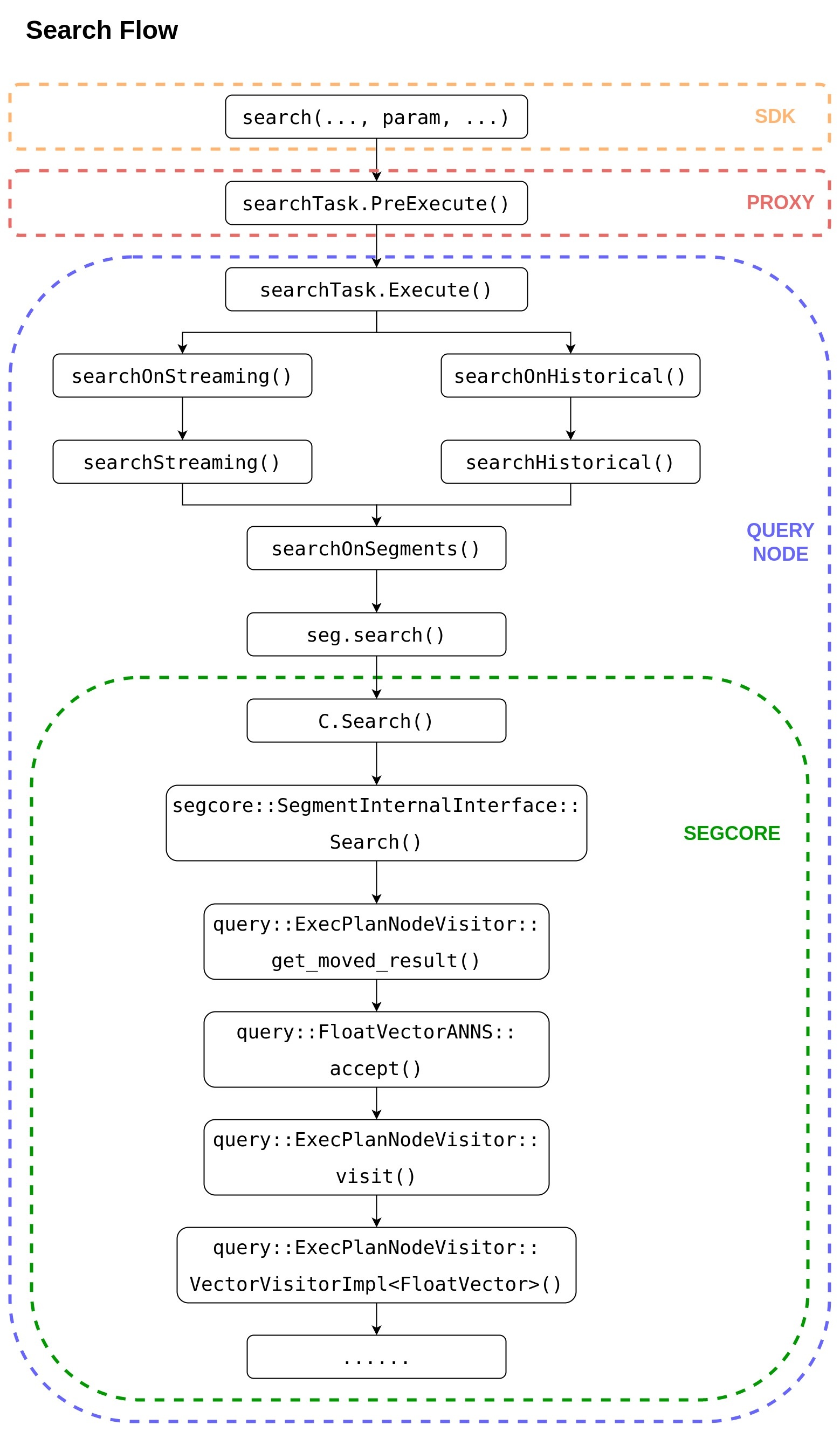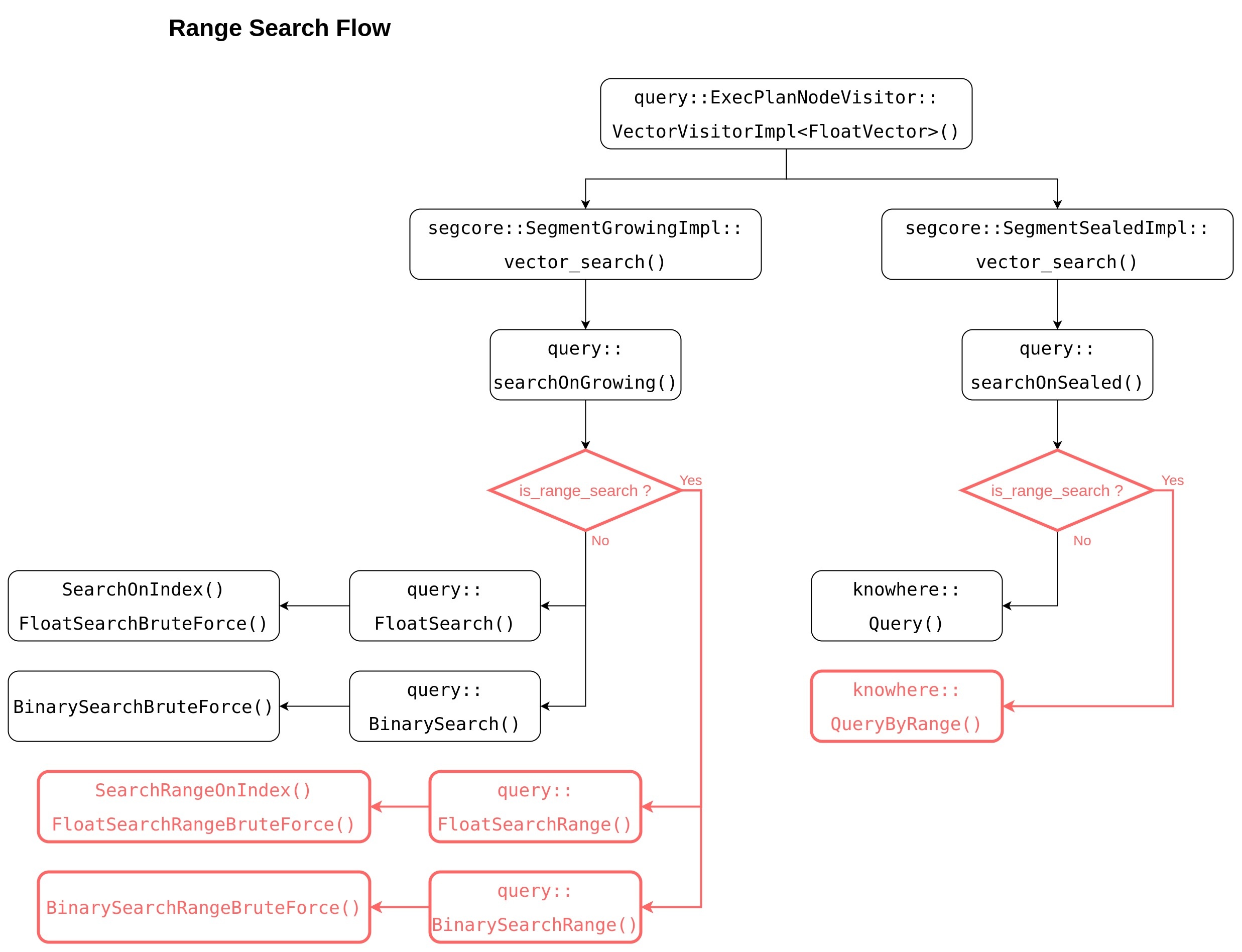Current state: ["Under Discussion"]
ISSUE: #17599
PRs:
Keywords: range search, radius
Released:
Summary(required)
目前 Milvus 已经实现的查询是为每个待查询向量返回 topk 个最相似的结果。
本项目的是为了实现另一种查询功能,用户指定查询半径 "radius",Milvus 查询并返回与待查询向量间距离优于 "radius" ("< radius" for "L2"; "> radius" for "IP" ) 的所有结果。
这一功能可以认为是现有查询功能的"超集",因为如果对 range search 的结果排序再取前 topk 个结果,就是现有查询功能的返回结果。
本项目的结果输出不同于原来的查询结果,原来的查询结果是定长的 nq * topk,而 range search 的返回结果是不定长的,除了 ids / distances 还会返回 lims 用以记录每条向量的查询结果在结果集中的偏移量。有另一个 MEP Pagination 会统一处理 Query 和 QueryByRange 的结果并返回给客户端,因此返回结果的处理不在本 MEP 讨论范围中。
Motivation(required)
有用户(做推荐系统)提需求希望 Milvus 能实现按距离查询的功能,即返回相似度优于某一阀值的所有结果。
Public Interfaces(optional)
Briefly list any new interfaces that will be introduced as part of this proposal or any existing interfaces that will be removed or changed.
我们复用了 Query 接口来实现 range search 的功能,因此 Milvus 的接口及所有 SDK 的接口不需要改变,只需要在 params 中加入 "radius" 信息即可。
当指定 "radius" 则忽略 "limit" 设定。
如下图所示,在 search_params.params 中加入 "radius": 888
default_index = {"index_type": "HNSW", "params":{"M": 48, "efConstruction": 500}, "metric_type": "L2"}
collection.create_index("float_vector", default_index)
collection.load()
search_params = {"metric_type": "L2", "params": {"ef": 32, "radius": 888}}
res = collection.search(vectors[:nq], "float_vector", search_params, limit, "int64 >= 0")
knowhere 中新加 QueryByRange 接口
virtual DatasetPtr QueryByRange(const DatasetPtr& dataset, const Config& config, const faiss::BitsetView bitset);
Design Details(required)
Describe the new thing you want to do in appropriate detail. This may be fairly extensive and have large subsections of its own. Or it may be a few sentences. Use judgment based on the scope of the change.
下图为一个 Search 请求从 SDK 到 SEGCORE 的完整调用栈,range search 完全复用该调用栈,不需要做任何改动。range search 只需要将参数 "radius" 在 SDK 端放入查询参数 "param" 中。
下图为 SEGCORE 内部向量查询时的调用栈示意图,黑色部分为现已实现的功能。
对于 sealed segment,要实现 range search 功能需要 knowhere 提供 QueryByRange 功能;
对于 growing segment 时,由于没有创建 index ,所以无法用 knowhere IDMAP 实现的暴搜功能,只能自己额外实现了暴搜的全套逻辑。若要实现 range search,需要另外实现红色部分所示的功能函数。
另一解决方案是,knowhere 提供一种新的 IDMAP 索引,该索引不需要插入向量数据,只需要指定向量数据的内存地址。growing segment 在查询时可临时生成该种索引,继而调用 IDMAP 提供的 Query & QueryByRange 接口,该索引在用完后也即刻销毁。此方案没有额外的内存开销,但是否可行需进一步调研。
查询结果的处理
Query 返回的查询结果有2种,一种为 SubSearchResult,用于存放 segment 中每个 chunk 的查询结果。
需要添加成员变量 "is_range_search_" 和 "lims_",以及成员函数 "merge_range()" 和 "merge_range_impl()"。
class SubSearchResult {
... ...
static SubSearchResult
merge(const SubSearchResult& left, const SubSearchResult& right);
void
merge(const SubSearchResult& sub_result);
static SubSearchResult
merge_range(const SubSearchResult& left, const SubSearchResult& right); // <==== new added
void
merge_range(const SubSearchResult& sub_result); // <==== new added
private:
template <bool is_desc>
void
merge_impl(const SubSearchResult& sub_result);
void
merge_range_impl(const SubSearchResult& sub_result); // <==== new added
private:
bool is_range_search_; // <==== new added
int64_t num_queries_;
int64_t topk_;
int64_t round_decimal_;
MetricType metric_type_;
std::vector<int64_t> seg_offsets_;
std::vector<float> distances_;
std::vector<size_t> lims_; // <==== new added
另一种为 SearchResult,用于存放该 segment 的查询结果。
需要添加成员变量 "is_range_search_" 和 "lims_"。
struct SearchResult {
... ...
public:
int64_t total_nq_;
int64_t unity_topK_;
void* segment_;
// first fill data during search, and then update data after reducing search results
bool is_range_search_; // <==== new added
std::vector<float> distances_;
std::vector<int64_t> seg_offsets_;
std::vector<size_t> lims_; // <==== new added
... ...
};
在 Query node 中还需要实现多个 segment 之间的 reduce_range();
在 Proxy 中还需要实现多个 SearchResult 之间的 reduce_range();
关于输出结果的处理,需要和 Pagination 的具体实现方案一起讨论。
Compatibility, Deprecation, and Migration Plan(optional)
- What impact (if any) will there be on existing users?
- If we are changing behaviors how will we phase out the older behavior?
- If we need special migration tools, describe them here.
- When will we remove the existing behavior?
Test Plan(required)
Describe in a few sentences how the MEP will be tested. We are mostly interested in system tests (since unit tests are specific to implementation details). How will we know that the implementation works as expected? How will we know nothing broke?
Rejected Alternatives(optional)
If there are alternative ways of accomplishing the same thing, what were they? The purpose of this section is to motivate why the design is the way it is and not some other ways.
References(optional)
Briefly list all references

